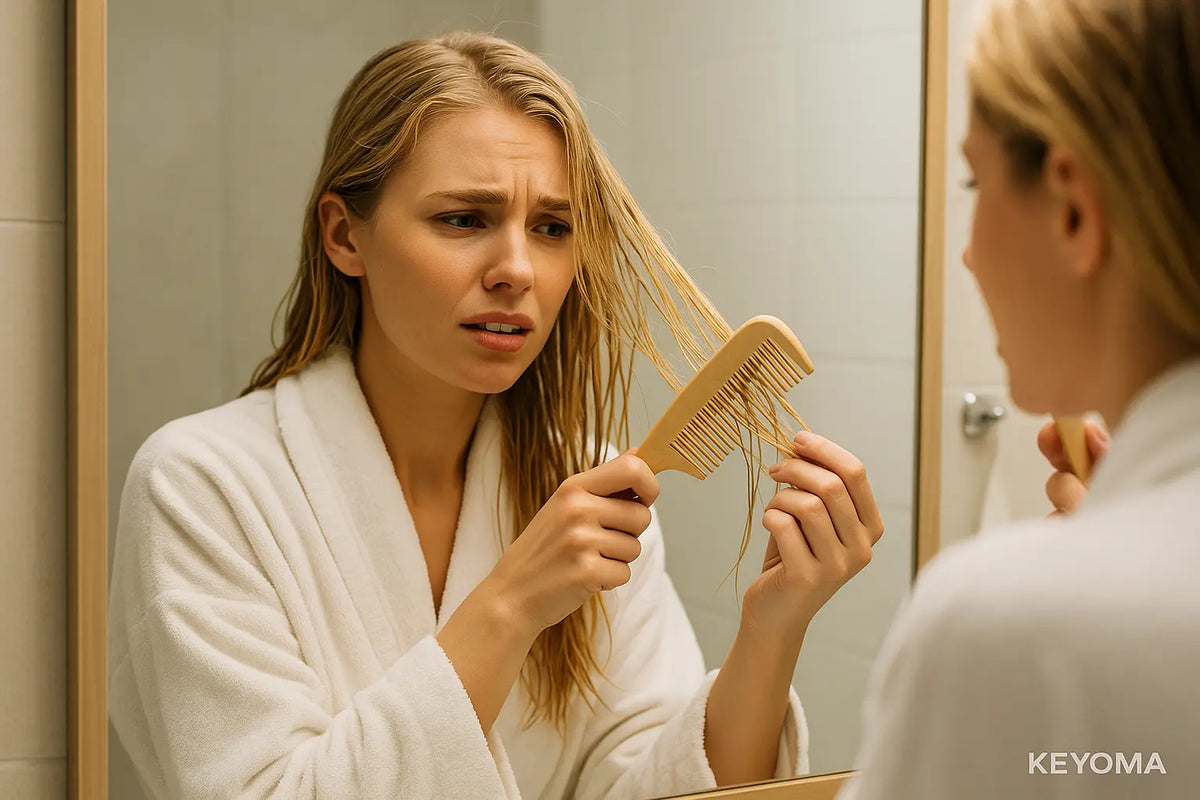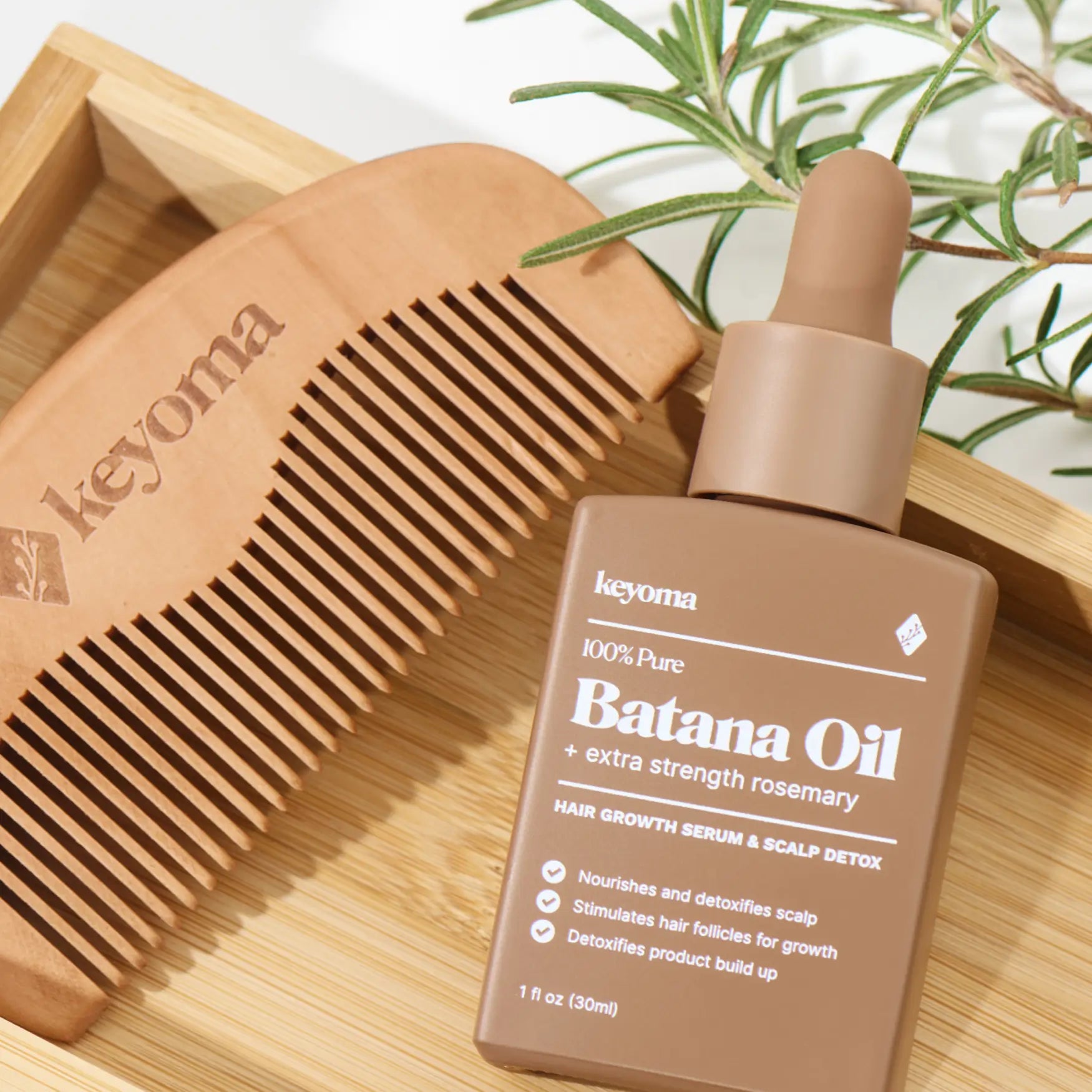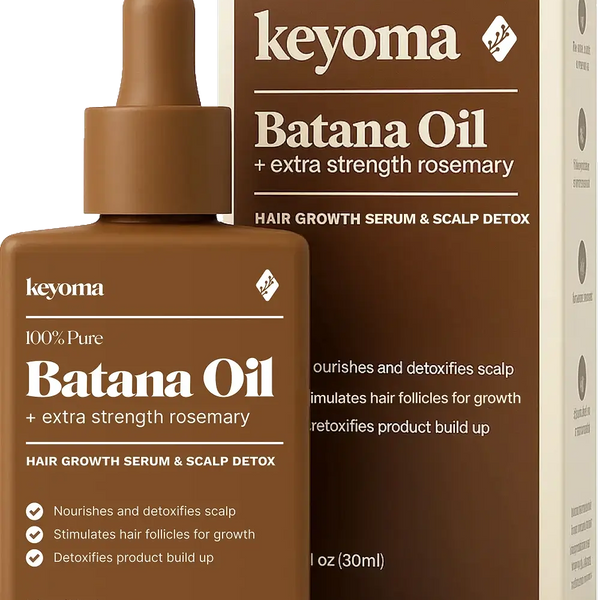In this article
You might be doing everything “right” for your hair—using the good shampoo, deep-conditioning on schedule, and sticking to your routine—but those same good intentions might be doing more harm than you realize.
And the truth is, it’s not just about what you are doing wrong. It’s also about what you’re not doing. The little habits you overlook (or skip altogether) can quietly weaken your strands and stall growth over time.
In this article, I’ll walk you through 18 common hair care mistakes that make hair loss worse, and more importantly, how to fix them so you can stop the damage, rebuild your routine, and finally start growing stronger, healthier hair again.
1. Neglecting Scalp Care
Most people focus entirely on their hair strands without realizing that the follicle itself sits under the scalp. And when that scalp is neglected, issues like dandruff, itchiness, flaking, clogged follicles, and even inflammation can start to build up.
Over time, this chokes off the nutrient supply to your follicles, slowing growth and triggering premature shedding.
All that is to say good scalp care habits are the foundation of healthy hair. Here’s what to start doing today:
-
Use nourishing oils. Oils help hydrate the scalp and reduce flaking while creating a healthier environment for your hair to grow. I personally love using batana oil infused with rosemary, although the classic coconut, castor, and peppermint oil works just as well.
-
Massage your scalp regularly. Just 2–5 minutes a day can stimulate blood flow, which helps bring oxygen and nutrients to the follicles. Pair it with hair oils and you get double the benefit.
-
Don't ignore signs of scalp issues. An itchy scalp, flakes that don’t go away, or tenderness when brushing are signs you shouldn’t ignore. These may point to buildup, fungus, or irritation that needs to be addressed.
2. Overwashing (or Underwashing)
Overwashing strips away the scalp's natural sebum, leaving it dry, irritated, and more prone to inflammation. It’s especially harsh if you’re using shampoos with sulfates or hot water.
Underwashing isn’t any better. It leaves your follicles clogged with trapped sweat, dirt, dead skin cells, throwing off microbial balance and, in some cases, even resulting in seborrheic dermatitis—an inflammatory condition strongly linked to hair loss.
What’s the right balance then?
-
Match your wash routine to your hair type and lifestyle. If you have an oily scalp or sweat often, washing 3–4x a week may be ideal. For drier scalps or textured hair types, 1–2x a week is enough. At the end of the day, the best approach is to listen to what your scalp is telling you.
-
Use a gentle, sulfate-free shampoo. Look for options that cleanse without stripping, especially if you're washing frequently. Rotate in a clarifying shampoo once every few weeks to reset your scalp.
-
Avoid or minimize hot showers. Stick to lukewarm water, and finish with a cool rinse to help seal the cuticle.
3. Overbrushing
Sure, brushing helps distribute natural oils, detangle your hair, and add a bit of shine. But that doesn’t mean you have to treat it like a workout with a hundred reps.
Every stroke that tugs at dry ends or sensitive roots creates micro-damage, which over time can lead to thinning in the most vulnerable areas, especially around the hairline or crown.
Here's what you should do:
-
Brush once or twice a day max. That’s all it takes to keep strands neat and help oil distribution. Any more than that is just friction your hair doesn’t need.
-
Use the right tool for combing. A wide-tooth comb for wet hair, a soft-bristle or paddle brush for dry strands. Avoid metal or sharp plastic bristles that scratch the scalp.
-
Start from the ends, not the roots. Work your way up in sections, gently detangling as you go.
4. Skipping Conditioner
Who needs conditioner if we already have shampoo to do the cleaning job? Well, we all do. The truth is, shampoo opens up the cuticle, while conditioner seals it back down.
Without that sealing process, your strands are left exposed, making them more vulnerable to breakage, frizz, and moisture loss.
On top of that, conditioner also plays a major role in reducing friction—preventing your hair from getting snagged or pulled from the root every time you brush or towel-dry.
Here's how to get it right:
-
Apply conditioner mid-shaft to ends. Your ends are the oldest and driest part of your hair and thus need the most attention. Avoid the roots unless your product specifically says it’s lightweight or scalp-safe.
-
Let it sit for a minute or two. That gives the ingredients time to absorb and coat the cuticle properly.
-
Rinse with cool water. This helps seal the cuticle and leaves your hair smoother and shinier.
5. Brushing Wet Hair
Wet hair is at its weakest. When saturated with water, the shaft swells and the cuticle lifts, making each strand more vulnerable to stretching, snapping, or splitting under even minimal tension.
So when you drag a brush through wet strands, you’re not just detangling. You’re also causing mechanical stress that can lead to breakage and long-term thinning.
If you have to brush your wet hair, always use a wide-tooth comb, not a brush. Adding a leave-in conditioner or detangling spray also helps add slip, so the comb glides through more easily.
6. Using Harsh Hair Products
Many people use products that smell amazing or claim to work miracles, but beneath the fancy packaging can be harsh formulas doing long-term damage. This includes:
-
Sulfates (like sodium lauryl sulfate or SLS) in shampoos
-
Parabens and formaldehyde-releasing preservatives in hair treatments
-
Alcohol-heavy formulas in sprays, mousses, or gels
-
Synthetic fragrances that often act as irritants, especially on sensitive scalps
These ingredients strip the scalp of its natural oils, disrupt pH balance, and degrade the cuticle layer of your strands, all of which weaken the hair shaft and make it prone to breakage.
All that said, make sure the products you pick off the shelf are free from these ingredients or carry “-free” labels (like sulfate-free or alcohol-free).
Products with nourishing alternatives such as rosemary, aloe vera, or chamomile are an even better choice for their added soothing and strengthening benefits.
And one last thing. Sometimes “harsh” just means your scalp doesn’t respond well to the formula. So if a product leaves you with burning, itching, or tightness, it’s time to toss it.
7. Using Too Much Hair Products at Once
When you’re having a bad hair day, the worst thing you can do is grab everything within reach and slather it on all at once. The only thing this does is create buildup that can clog your follicles and throw your scalp’s balance off, eventually leading to shedding or even hair loss.
Instead, stick to what your hair actually needs. A leave-in, a nourishing oil, and a styling product are usually enough. You don’t need everything at once.
You can also alternate between moisture-based and protein-based treatments depending on what your hair needs that week.
Finally, clarify once or twice a month using a gentle clarifying shampoo to reset your scalp and remove buildup from styling products and oils.
8. Too Much Heat Styling
Heat styling tools like flat irons, curling wands, and blow dryers are styling staples for when we’re rushing or trying to fix a bad hair day..
However, too much heat can cause serious damage over time. High temperatures break down the hydrogen bonds that shape your hair’s structure while stripping away natural moisture from both the strand and the cuticle layer. The result? Brittle, dull, frayed hair that breaks off more easily.
That said, it’s all about moderation. As much as possible, save heat styling for special occasions. Always use a heat protectant to minimize the damage, and turn down the temperature, ideally below 300°F, especially if you have fine or color-treated hair.
9. Wearing Tight Hairstyles for Extended Periods
From Ariana Grande’s sky-high ponytail to Kim K’s sleek buns or Black Panther’s Okoye and her striking cornrows. Tight hairstyles can look powerful and polished, but when worn too often or for too long, they can quietly do real damage underneath.
Tension-based styles like those mentioned pull on your hairline and roots, creating sustained mechanical stress. This constant pulling can damage the follicle and lead to a form of hair loss called traction alopecia.
It often starts as thinning along the temples or nape, and can become permanent if the follicle is scarred.
Here’s how to wear your favorite styles without the fallout:
-
Loosen the grip. Go for softer buns, lower ponytails, and gently-secured braids. Any low-tension hairstyle works.
-
Alternate your styles. Let your scalp and follicles rest by switching to looser hairstyles in between.
-
Watch your edges. The hairline is most vulnerable to pulling. Apply nourishing oils like batana or castor oil to keep edges moisturized and resilient.
10. Excessive Chemical Treatments
Whether it’s coloring, relaxing, perming, bleaching, or rebonding, chemical treatments promise dramatic transformations that make us feel refreshed, confident, and beautiful.
However, chemical treatments break down your hair’s protein bonds (especially keratin) to reshape or recolor the strand. That in itself is already technically damaging, but overlapping treatments compounds chemical damage and can lead to serious breakage and shedding.
To protect your strands without giving up your favorite look:
-
Space out chemical treatments. If you’ve just bleached your hair, wait at least 8–10 weeks before applying another chemical service. Give your strands time to rebuild.
-
Avoid overlapping chemicals. Never layer a relaxer on hair that was recently colored, or bleach over freshly permed hair. These combinations are high-risk.
-
Use bond-repair treatments. Incorporate protein masks and bond-repairing formulas into your weekly routine.
-
Ask your stylist for gentle alternatives. Ammonia-free dyes, low-volume developers, and protein-infused formulas exist. Don’t be afraid to ask.
11. Aggressive Towel-Drying
You step out of the shower, wrap your towel around your head, and start rubbing like you’re scrubbing a countertop. We’ve all done it, often without realizing how much it quietly ruins our strands.
When your hair is wet, it's swollen with water and more elastic. Rubbing it with a regular bath towel creates friction that lifts the cuticle, causes frizz, and breaks weakened strands.
Here’s what to do instead:
-
Blot, don’t rub. Use a microfiber towel or a soft cotton t-shirt to gently press out excess water. It absorbs moisture without the harsh rubbing.
-
Wrap it gently. If you like wrapping your hair post-shower, avoid twisting it tightly at the crown. Let it sit loose.
-
Let hair air-dry when possible. Especially if you’re not in a rush. This minimizes both heat and friction damage.
12. Overusing Dry Shampoo
Dry shampoo is great for refreshing greasy roots especially on mornings when you’re busier than usual.
But despite its time-saving benefits, using it too often—almost as if it were a replacement for actual washing—does more harm than good. It can build up, clog pores, and create an environment that’s far from ideal for healthy hair growth.
With that said, keep these in mind:
-
Use dry shampoo sparingly. Once or twice a week is plenty. It’s meant to buy you time, not replace shampoo.
-
Clarify weekly. Use a gentle clarifying shampoo to remove buildup if you regularly use styling products, including dry shampoo.
-
Wash your scalp properly. Nothing beats water and a good sulfate-free shampoo when it comes to truly cleansing your roots.
13. Unhealthy Eating Habits
When we think about hair care, we usually picture shampoos, serums, masks, and other topical treatments. What rarely comes to mind is that what we eat plays just as big a role, if not a bigger one.
When your diet is poor, your body redirects nutrients to vital organs first, leaving your hair—considered non-essential—last in line. That’s when you start noticing thinning, shedding, and slower growth.
Some eating habits or diets to be cautious of include:
-
Crash diets: Rapid weight-loss diets drastically cut calories and nutrients, which forces your body into a stress state. This can push more follicles into the telogen (resting) phase, leading to noticeable shedding within weeks.
-
High-sugar diets: Constantly eating processed sweets, sodas, and refined carbs spikes insulin and inflammation. Over time, this weakens follicles, disrupts growth cycles, and makes hair more prone to breakage.
-
Restrictive diets (like keto or veganism, when not planned properly): Eliminating entire food groups without proper substitutes can lead to protein, iron, or B-vitamin deficiencies, all of which are essential for strong, healthy hair.
On that note, here are a few do’s to support healthy hair growth through your diet:
-
Eat a balanced, whole-food diet. Prioritize protein (eggs, chicken, lentils), iron-rich foods (leafy greens, beef), and healthy fats (avocados, nuts, salmon).
-
Hydrate properly. Hair follicles need water to stay plump and function efficiently. Dehydration makes hair brittle and lifeless.
-
Consult a doctor or nutritionist. Especially if you follow a restrictive diet, professional guidance can help identify deficiencies and determine whether supplements are necessary.
14. Ignoring Stress
Stress spikes your body’s cortisol levels, and when cortisol stays elevated for long periods, it can push more follicles into the telogen phase of the hair growth cycle, leading to shedding.
Even worse, chronic stress can contribute to inflammation, disrupt hormone balance, and weaken the scalp barrier, making your follicles more vulnerable to damage.
Below are simple practices you can do that's proven to lower stress:
-
Build a stress-relief routine. Meditation, journaling, deep breathing, and even simple walks can help reset your nervous system.
-
Sleep well. Aim for 7–8 hours of quality sleep per night to allow your body to repair and regulate hormones.
-
Move your body. Regular physical activity helps reduce cortisol and increases blood flow to the scalp.
15. Skipping Regular Trims
If you’re growing out your hair, skipping trims might feel like the logical thing to do. But here’s the irony: avoiding the scissors for too long can actually stunt your length in the long run.
As your hair grows, the ends naturally become weaker and more prone to splitting. When those split ends are left unchecked, they travel up the shaft, damaging healthy length and causing breakage higher up.
So instead of gaining inches, you end up losing more from mid-length breakage than you would’ve from a simple trim.
Here’s how to protect your length when trimming:
-
Stick to a schedule. For most people, trimming every 2 to 3 months keeps damage under control without compromising length goals.
-
Ask for a dusting. If you're nervous about losing inches, ask your stylist for a micro-trim or dusting, just enough to remove the frayed ends.
-
Consider low-maintenance hairstyles. A haircut that requires less daily manipulation means less damage, fewer tangles, and more length retention over time.
16. Sleeping On Cotton Pillowcases
Cotton is absorbent and textured. When your strands rub against it night after night, the outer cuticle layer lifts and weakens, leading to dryness, frizz, and breakage.
This damage is especially noticeable for those with curly, coily, or chemically treated hair, where moisture retention is already a struggle.
Here’s what to do:
-
Use silk or satin pillowcases. These materials are smooth, allowing your hair to glide across the surface without pulling or drying out.
-
Wrap your hair at night. If switching pillowcases isn’t an option, use a satin or silk bonnet or scarf to protect your hair.
-
Moisturize before bed. Lightly apply a nourishing oil or leave-in conditioner before you sleep to help lock in moisture and minimize overnight dryness.
17. Not Wearing Sun Protection
Prolonged sun exposure weakens the structural integrity of the cuticle layer, fades color, dries out strands, and contributes to oxidative stress on your scalp.
Over time, this leads to rough texture, dullness, and in some cases, increased hair shedding.
Here’s how to protect your hair from the sun:
-
Use UV-protectant hair products. Look for leave-in sprays or serums that offer SPF protection for both your scalp and strands.
-
Wear a hat. A wide-brimmed hat or UPF-rated cap offers physical protection, especially during peak sunlight hours.
-
Moisturize regularly. Oils like batana, argan, or coconut oil form a barrier against environmental stressors and lock in hydration.
18. Skipping Pre- and Post-Swim Protection
Chlorine and saltwater during swim sessions strip the hair of its natural oils, dehydrate the shaft, and degrade the protective cuticle.
Chlorine, in particular, is a chemical oxidizer. It lifts the hair’s outer layer and reacts with keratin proteins inside, making hair feel dry, brittle, and prone to breakage.
So whether you're hitting the beach or getting laps in at the pool (especially in summer), don't forget these pre-and post-swim hair care practices:
-
Pre-rinse with fresh water. Wetting your hair before diving in makes it less likely to absorb chlorinated or salty water.
-
Apply a protective layer. Coat your strands with a leave-in conditioner or light oil like batana or coconut oil. This acts as a barrier and slows down chemical absorption.
-
Wear a swim cap. Especially if you’re swimming regularly, it’s the easiest way to shield your strands from direct exposure.
-
Rinse and cleanse immediately after. Use a gentle, sulfate-free shampoo followed by a hydrating conditioner. If needed, use a swimmer’s shampoo once a week to remove mineral and chlorine buildup.
Featured Product
100% Pure Batana Oil + Rosemary









